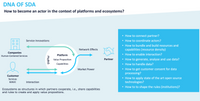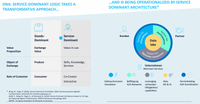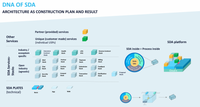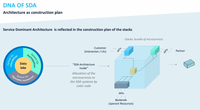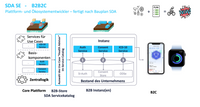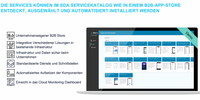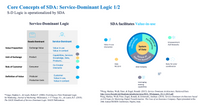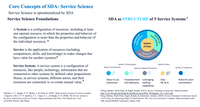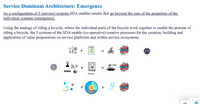Service Dominant Architecture (SDA)
Service Dominant Architecture is a construction plan for the collaborative creation, building and application of value propositions on digital service platforms.
For this purpose SDA operationalizes core concepts of Service-Dominant Logic and Service Science.
As a configuration of 5 (service) systems SDA enables results that go beyond the sum of the properties of the individual systems (emergence). Using the analogy of riding a bicycle, where the individual parts of the bicycle work together to enable the process of riding a bicycle, the 5 systems of the SDA enable co-operative processes for the creation, building and application of value propositions on service platforms and within service ecosystems.
Classification and Unique Selling Point
The five SDA systems are already implemented in the software modules with "SDA inside". This makes it possible to pass through events, data or other capabilities that are generated, for example, in the course of interactions or through the connection of external partners. In the admittedly "rough" analogy of a house, this corresponds to the stones that pass through electricity, water or internet cables.
Origination
Service Dominant Architecture was published in 2014 by Markus Warg. It operationalizes core concepts of Service Science and Service-Dominant Logic.
Service-Dominant Logic (Steve Vargo, Robert Lusch, 2004, https://sdlogic.net/index.html ) explains the shift from Goods-Dominant Logic, where the focus is on the good for good or value for value exchange, to Service-Dominant Logic where the focus is on service for service exchange and value cocreation.
SDA Perspectives: SDA can be viewed from a conceptual and an applied perspective:
(1) firstly, SDA as a conceptual framework (Blaxter, Hughes, Tight, 1996; Leshem & Trafford, 2007) in the understanding of a structure as a virtual order (Giddens, 1984) or design pattern (Alexander et al, 1977; Gamma, Helm, Johnson, Vlissides, 2000) of five systems (Cardoso et al, 2015; Luhmann, 1996; Spohrer, Vargo, Caswell, Maglio, 2008).
(2) secondly, SDA as tangible structure instantiated (e.g., based on platform technologies) by at least one (responsible actor) entity (Giddens, 1984). The instantiated structure consists of five systems including the SDA service catalog as system of shared institutional arrangements (Spohrer & Maglio, 2008). SDA applied within an actor-to-actor network facilitates the process and coordination of service exchange and mutual value creation (Vargo & Lusch, 2016).
Five Systems Orchestrated with SDA Design Patterns: In the following the five systems of SDA and their roles are introduced (Warg, Weiss, Engel, 2015; Warg, Weiss, Engel, Zolnowski 2016):
1. System of Operant Resources: The system of operant resources is the heart of the SDA. It represents the workbench, where the various resources and capabilities are brought together and processed. For this, this system applies certain logics or processes. In line with S-D Logic, the focus is on intangible capabilities, previously defined as operant resources (like competence, knowledge, skills, software code), which are used and brought together to (co-) create value propositions. The emergence of value propositions is dependent on the achievable level of resource density. A high resource density positively impacts the possible combinations and thus the emergence and creation of innovative value propositions.
2. System of Interaction: The system facilitates value in use and value in context by enabling the application of capabilities bundled in value propositions. Interaction enables resource integration and service exchange between actors and by this new resources with value creating potential.
3. System of Participation: The concept of co-creation includes other (external) actors as co-producers of the value proposition. In this process the system of participation enables actor-to-actor orientation and the participation of other actors by coordinating actors and facilitating the process of resource integration.
4. System of Operational Data Stores (Data Lake): From an actors (e.g. organization) point of view, data received and generated by interacting with other actors (e.g. customer) should be systematically recorded and evaluated in real time. In this way, data and knowledge about the preferences and the context of other actors like customers can be build up continuously.
5. System of Institutional Arrangements (service catalog): As rules, institutions enable the coordination of actors and the access to and use of resources. In conjunction with design pattern, institutions enable the coordinated creation of solution designs by connecting actors, and enabling the integration of resources.
More details please find SERVICE DOMINIERTE ARCHITEKTUR (SDA)
Challenge
SDA enables partners (actors) to interact in a planned manner and to provide capabilities such as knowledge, algorithms, solutions or products in order to jointly create value propositions. Implemented on a technical platform, the value propositions B2C can be used by the partner (actor) customer by means of interaction to achieve immediate utility ("value in use"). B2B, in terms of cooperation, the capabilities can be reused and extended to continuously develop new combinations and innovations.
It is unique as a structure and architecture in that it enables the process of joint, cooperative value creation (value co-creation) by multiple actors (companies, partners, startups, end customers) end-to-end and completely digitally.
These approaches are also referred to as service-dominant, as the benefit for the actor is created through the engagement and application of a variety of capabilities. Service as the application of resources and capabilities for the benefit of another dominates the process in which the product remains an important component.
Scientific background PUBLIKATIONEN
SDA is grounded in the Core Concepts of Service-Dominant Logic and Service Science

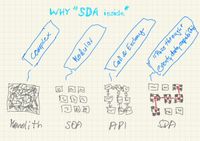

.png/picture-200?_=17eb0f2e740)

